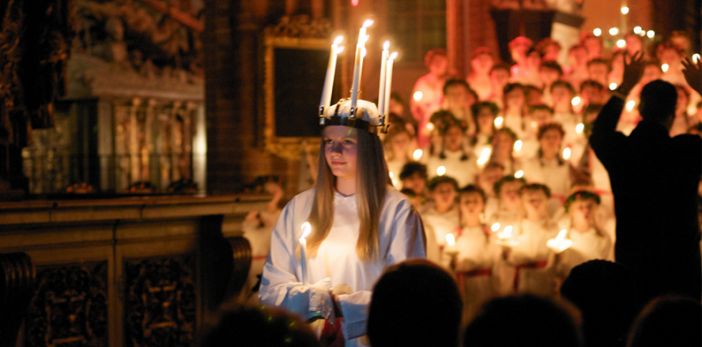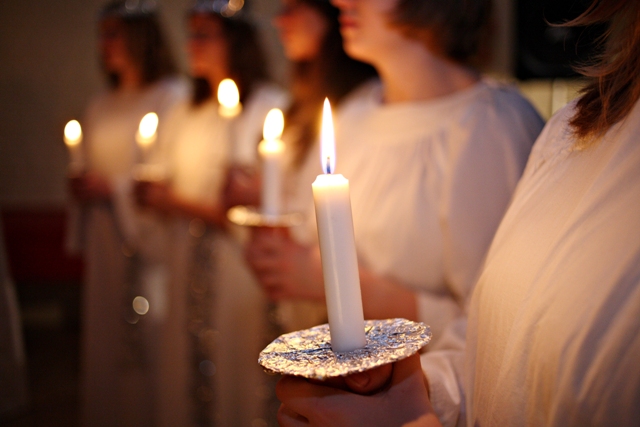All you need to know about Lucia's Day in Sweden
Visit Sweden on, or before December 13th, you'll have chance to immerse yourself in a very Swedish celebration, the 400-year-old Lucia's Day.
The origins of Lucia's Day in Sweden
 |
Dressed as Lucia’s maidens, in flowing white gowns, each girl holds a candle and wears a wreath of glowing candles in her hair. (source: viewstockholm.com)
According to the official site of Sweden sweden.se, the Lucia tradition can be traced back both to the martyr St Lucia of Syracuse (died in 304) and to the Swedish legend of Lucia as Adam’s first wife. It is said that she consorted with the Devil and that her children were invisible infernals.
"The name may be associated with both lux (light) and Lucifer (Satan), and its origins are difficult to determine. The present custom appears to be a blend of traditions," the site says, noting that "in the old almanac, Lucia Night was the longest of the year. It was a dangerous night when supernatural beings were abroad and all animals could speak. By morning, the livestock needed extra feed. People, too, needed extra nourishment and were urged to eat seven or nine hearty breakfasts."
"The last person to rise that morning was nicknamed ‘Lusse the Louse’ and often given a playful beating round the legs with birch twigs. In agrarian Sweden, young people used to dress up as Lucia figures (lussegubbar) that night and wander from house to house singing songs and scrounging for food and schnapps," the site says.
The first recorded appearance of a white-clad Lucia in Sweden was in a country house in 1764. The custom did not become universally popular in Swedish society until the 1900s, when schools and local associations in particular began promoting it. The old lussegubbar custom virtually disappeared with urban migration, and white-clad Lucias with their singing processions were considered a more acceptable, controlled form of celebration than the youthful carousals of the past. Stockholm proclaimed its first Lucia in 1927. The custom whereby Lucia serves coffee and buns (lussekatter) dates back to the 1880s.
White gowns, stars and candles
White gowns, stars and candles are indispensable objects in traditional Lucia celebration. Nowadays, the real candles once used are now often battery-powered, but there is still a special atmosphere when the lights are dimmed and the sound of the children singing grows as they enter from an adjacent room.

|
Each of her handmaidens carries a candle (source: Andersonville.org)
Tradition has it that Lucia is to wear ‘light in her hair’, which in practice means a crown of electric candles in a wreath on her head. Each of her handmaidens carries a candle, too. Parents gather in the dark with their mobile cameras at the ready.
The star boys, who like the handmaidens are dressed in white gowns, carry stars on sticks and have tall paper cones on their heads. The brownies bring up the rear, carrying small lanterns.
Who gets to be Lucia?
In Sweden, there used to be a competition for the role of Lucia – on national TV as well as on a local level in towns and schools all over the country. Local newspapers invited subscribers to vote for one or other of the candidates. Today, no national ‘Lucia of Sweden’ is elected and schools often let chance decide who’s to be Lucia, for example by organising a draw.
In general, Sweden avoids ranking people, which is why beauty contests and ‘homecoming queen’ events are rare. The Lucia celebration used to be an exception, until it was deemed obsolete.
Alongside Midsummer, the Lucia celebrations represent one of the foremost cultural traditions in Sweden, with their clear reference to life in the peasant communities of old: darkness and light, cold and warmth.
Lucia is an ancient mythical figure with an abiding role as a bearer of light in the dark Swedish winters.
The many Lucia songs all have the same theme:
The night treads heavily
around yards and dwellings
In places unreached by sun,
the shadows brood
Into our dark house she comes,
bearing lighted candles,

Jean-Philip Grobler of St. Lucia performs at Saturn Birmingham on June 9, 2016 in Birmingham, Alabama. (Photo by David A. Smith/Getty Images)
Another good place to see a Lucia procession is at Skansen, a large open-air museum and park in Stockholm. There are normally several concerts per day, but go early if you want a good seat.
"I highly recommend you to go to Lucia concert. Lucia concert is held in a lot of places but especially in the cathedral. A lot of young children will dress up like Lucia, angel, star-boys, or Santa and sing songs in the old Swedish tradition. Last year, I wanted to go to the Lucia concert at Uppsala Cathedral, but all the tickets were sold out, so I instead took a train for an hour to Stockholm and went to the Lucia concert. Even though it was freezing and far away from my place, it was worth seeing it. I enjoyed seeing Lucia’s performances. All the children so so beautiful with their wonderful voices. The video below is the one I took from the last year Lucia’s concert!" suggested Hyunjin, a Korean student taking Master Degree in Statistics at Uppsala University, Stockholm.
If you are not staying in Sweden, you still can immerse in the atmosphere since there are Lucia concerts all over the world. For example, in the UK, the Swedish Church in London organises Lucia concerts in St Paul's Cathedral, Southwark Cathedral and Ulrika Eleonora Swedish Church. (Tickets are expensive, but they are always snapped up quickly)./.
( VNF (compiled) )
Recommended
 Handbook
Handbook
Vietnam Moves Up 8 Places In World Happiness Index
 Handbook
Handbook
Travelling Vietnam Through French Artist's Children Book
 Multimedia
Multimedia
Vietnamese Turmeric Fish among Best Asian Dishes: TasteAtlas
 Handbook
Handbook
From Lost to Found: German Tourist Thanks Vietnamese Police for Returning His Bag
Popular article
 Handbook
Handbook
Prediction and Resolution for the Disasters of Humanity
 Handbook
Handbook
16 French Films To Be Shown For Free During Tet Holiday In Vietnam
 Handbook
Handbook
Unique Cultural and Religious Activities to Welcome Year of the Snake
 Handbook
Handbook



